The AMD Threadripper 2 CPU Review: The 24-Core 2970WX and 12-Core 2920X Tested
by Ian Cutress on October 29, 2018 9:00 AM EST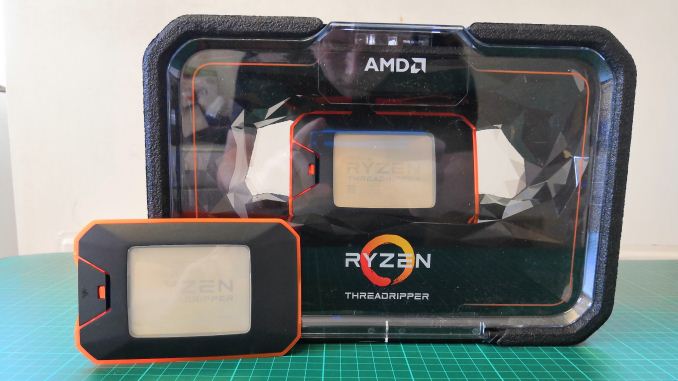
This year AMD launched its second generation high-end desktop Ryzen Threadripper processors. The benefits of the new parts include better performance, better frequency, and parts up to 32 cores. We tested the first two processors back in August, the 32-core and the 16-core, and today AMD is launching the next two parts: the 24-core 2970WX and the 12-core 2920X. We have a full review ready for you to get your teeth in to.
Building out the HEDT Platform
When AMD first launched Threadripper in the summer of 2017, many considered it a breath of fresh air in the high-end desktop space. After several generations of +2 cores per year, but PCIe staying the same and pricing hitting $1721 for a 10-core, here was a fully-fledged 16 core processor for $999 with even more PCIe lanes. While it didn’t win medals for single core performance, it was competitive in prosumer workloads and opened up the floodgates to high core-count processors in the months that followed. Fast forward twelve months, and AMD doubled its core count with the Threadripper 2990WX, a second generation processor with 32 cores and upgraded 12nm Zen+ cores inside, fixing some of the low hanging fruit on performance.
While that first generation was AMD’s first crack at the HEDT market for a few years, it was really the stepping stone for the second generation that allows AMD to stretch its legs. In the first generation, users were offered three parts, of 8, 12, and 16 cores, using two zeppelin dies of eight cores each, and then cut down for the less than 16 core parts. For the second generation of Threadripper, the 8 core is dropped, but the stack is pushed higher at the top end, with AMD now offering new 24-core and 32-core parts.
| AMD SKUs | |||||||
| Cores/ Threads |
Base/ Turbo |
L3 | DRAM 1DPC |
PCIe | TDP | SRP | |
| TR 2990WX | 32/64 | 3.0/4.2 | 64 MB | 4x2933 | 60 | 250 W | $1799 |
| TR 2970WX | 24/48 | 3.0/4.2 | 64 MB | 4x2933 | 60 | 250 W | $1299 |
| TR 2950X | 16/32 | 3.5/4.4 | 32 MB | 4x2933 | 60 | 180 W | $899 |
| TR 2920X | 12/24 | 3.5/4.3 | 32 MB | 4x2933 | 60 | 180 W | $649 |
| Ryzen 7 2700X | 8/16 | 3.7/4.3 | 16 MB | 2x2933 | 16 | 105 W | $329 |
AMD launched the first two processors, the 16-core 2950X and the 32-core 2990WX, back in August. We did a thorough review, which you can read here, and due to the new features we had some interesting conclusions. Today AMD is lifting the embargo on the other two processors, the 12-core 2920X and the 24-core 2970WX, which should also be on shelves today.
Comparing what AMD brought to the table in 2017 to 2018 gives us the following:
| 2017 | 2018 | |||
| - | $1799 | TR 2990WX | ||
| - | $1299 | TR 2970WX | ||
| TR 1950X | $999 | $899 | TR 2950X | |
| TR 1920X | $799 | $649 | TR 2920X | |
| TR 1900X | $549 | |||
There is no direct replacement for the 1900X - in fact AMD never sampled it to reviewers, thus I kind of assume it didn't sell that well.
Constructing Threadripper 2
Rather than building up from Ryzen, AMD took its enterprise grade design in its EPYC platform and has filtered it down into the high-end desktop.
EPYC, with its large 4096-pin socket, was built on four lots of the eight-core Zeppelin die, with each die offering two memory channels and 32 PCIe lanes, to give a peak everything of 32 cores, 64 threads, 128 PCIe lanes, and eight memory channels.
The first generation Threadripper took the same hardware and halved it – two active Zeppelin dies for 16 cores / 32 threads, quad channel memory, and 64 PCIe lanes (or 60 + chipset). For Threadripper 2, some of those EPYC features come back to the consumer market: no more memory channels or PCIe lanes, but those two inactive dies are reactivated to give up to 32 cores again for the WX series. The X series doesn’t get that, but they both get generational improvements, such as Zen+ and 12nm.
The new Threadripper 2 platform takes advantage of AMD’s newest Zen+ microarchitecture which is good for +3% performance at the same clock speed, but also the 12nm manufacturing node, which improved frequencies for an overall 10% improvement. We found AMD’s claims to be accurate on Zen+ and 12nm in our Ryzen 2000-series review.
Due to the way TR2 is laid out, we now have one Zeppelin die connected to two memory channels, another Zeppelin die connected to another two memory channels, and the two new active dies not connected to any memory, and thus to access memory, it has to perform an additional hop to do so. In memory bound testing, this can have obvious implications.
So when we tested the 32-core 2990WX and the 16-core 2950X, this is pretty much what we saw. The 2950X performed similarly to the 1950X, but with better per-core performance and higher frequencies. The 2990WX however was a mixed bag – for non-memory limited workloads, it was a beast, ripping through benchmarks like none-other. However for applications that compete for memory, it regressed somewhat, sometimes coming behind the 2950X in performance. Ultimately our suggestion was that the 2990WX is a monster processor, if you can use it, otherwise the 2950X was the smart purchase.
So with the new 2970WX and 2920X in this review, the 24-core and 12-core part, AMD has taken the 2990WX and 2950X processors and disabled two cores per Zeppelin die, giving 6+6+6+6 and 6+6 configurations. This has some pros and cons: having fewer cores per die means that larger threaded workloads will get additional latency between core-to-core communications, but the plus side is that the program moves onto a second die sooner, allowing the power budget to rise faster to get a better frequency.
New Features: Dynamic Local Mode
For this second set of CPUs, AMD is also releasing a new mode for the 24-core 2970WX and the 32-core 2990WX called ‘Dynamic Local Mode’. This new mode will be selectable initially from the Ryzen Master software, but will eventually be made available through the chipset driver. The goal of this new mode is to improve performance.
When Threadripper first launched, it was the first mainstream single socket processor to have a non-uniform memory architecture: as each eight core Zeppelin die inside had direct access to two memory channels and extended access to the other two, it made the system unequal, and users had to decide between high bandwidth by enabling all four memory channels (default) or low latency by having each thread focus on the two memory channels closed. With Threadripper 2, especially with the four die variants, this problem takes another turn as the two dies not connected to memory will always have to jump through in order to execute a memory access.
What Dynamic Local Mode does involves some higher level adjustment of where programs are located on the chip. Through a system service, it measures the CPU time of active threads and ranks them from most demanding to least demanding, and then places the most demanding threads onto the Zeppelin dies with local memory access. The idea here is that by fixing the single thread or low thread programs to the primary silicon dies with the best performance, then overall system performance will increase. For fully multithreaded workloads, it won’t make much difference.
AMD is claiming that it offers around 10% better performance in some games at 1080p, and up to 20% in specific SPECwpc workloads. We should get round to testing this for a future article, however it will be more important when it becomes part of the chipset driver.
Old Features: Precision Boost Overdrive (PBO)
One feature not to forget is Precision Boost Overdrive.
Because AMD uses its Precision Boost 2 model for determining turbo frequency, it is not bound to the older ‘cores loaded = set frequency’ model, and instead attempts to boost as far as it can within power and current limits. Combined with the 25 MHz granularity of the frequency divider, it usually allows the CPU to make the best of the environment it is in.
What PBO does is increase the limits on power and current, still within safe temperature limits, in order to hopefully increase performance over a wide range of scenarios, especially heavily multithreaded scenarios if there is headroom in the motherboard power delivery and in the cooling. AMD claims around a 13% benefit in tasks that can benefit from it. PBO is enabled through the Ryzen Master software.
The three key areas are defined by AMD as follows:
- Package (CPU) Power, or PPT: Allowed socket power consumption permitted across the voltage rails supplying the socket
- Thermal Design Current, or TDC: The maximum current that can be delivered by the motherboard voltage regulator after warming to a steady-state temperature
- Electrical Design Current, or EDC: The maximum current that can be delivered by the motherboard voltage regulator in a peak/spike condition
By extending these limits, PBO gives rise for PB2 to have more headroom, letting PB2 push the system harder and further.
AMD also clarifies that PBO is pushing the processor beyond the rated specifications and is an overclock: and thus any damage incurred will not be protected by warranty.
Old Features: StoreMI
AMD’s solution to caching technology is StoreMI, which allows users to combine a spinning rust HDD, up to a 256GB SSD, and up to 2GB of DRAM into a single unified storage space. The software deals with moving the data around to keep access times small, with the goal of increasing performance.
This is done after installing Windows, and can be disabled or adjusted at any time. One downside is if one drive fails, the whole chain is lost. However, AMD claims that in a best case scenario, StoreMI can improve loading times up to 90% over a large hard drive.
Motherboard Support
As promised by AMD, these new processors will fit straight into the X399 motherboard, with a BIOS update. Those motherboards already updated to support the 2990WX and 2950X will already have support for the 24-core and 12-core.
Some users will express concern that some of the motherboards might not be suitable for the 250W TDP parts. That may be true for some of the cheaper motherboards when users are overclocking, but users investing in this platform should also be prepared to invest in good cooling and making sure all the power circuitry is also actively cooled. We have seen MSI release the X399 MEG Creation as a new motherboard for these processors, GIGABYTE now has the X399 Aorus Extreme, and ASUS has released a cooling pack for its ROG Zenith Extreme.
We’ve reviewed over half the X399 motherboards currently on the market. Feel free to read our reviews:
| X399 Reviews | |||
| ASRock X399 Taichi |
MSI MEG X399 Creation |
Threadripper 2 2990WX Review |
Best CPUs |
_678x452.png) |
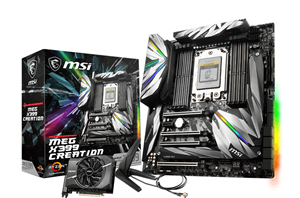 |
%20-%20Copya_678x452.jpg) |
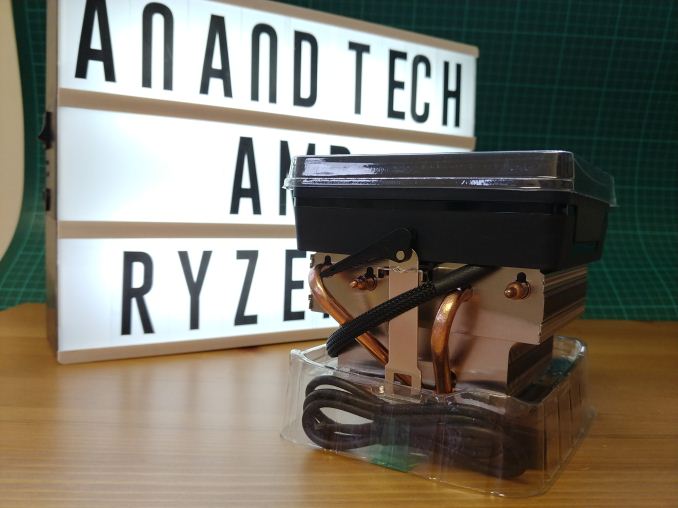 |
| ASUS X399 ROG Zenith Extreme |
ASRock X399 Pro Gaming |
GIGABYTE X399 Designare EX |
X399 Overview |
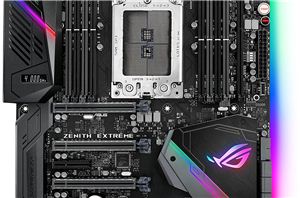 |
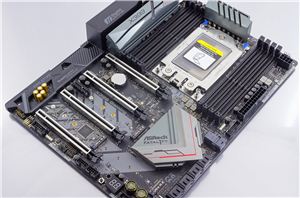 |
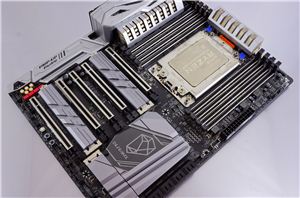 |
 |
For our testing, we’ve been using the ASUS X399 ROG Zenith Extreme, and it hasn’t missed a beat. I am a sucker for good budget boards, and that MSI X399 SLI Plus looks pretty handy too.
Competition and Market
Combating AMD’s march on the high-end desktop market is the blue team. Intel’s Skylake-X is still holding station, topping out with the Core i9-7980XE down to the Core i7-7800X. For this review we’ve actually got every single one of that family tested for comparison.
Intel is set to be launching an update to Skylake-X sometime in Q4, as was previously announced, with updates from the i7-9700X up to the i9-9980XE. On paper the major differences are the increased frequencies, increased L3 victim cache sizes, and increased power, as Intel is using HCC silicon across the board. We’ll test those when we get them in, but it will still be AMD’s 32-core vs Intel’s 18-core at the high end.
If you want to be insane, Intel will also be launching an overclockable 28-core Xeon W-3175X this year, although we expect it to be very expensive.
Pages In This Review
- Analysis and Competition
- Power Consumption and Uncore Update: Every TR2 CPU Re-tested
- Test Bed and Setup
- 2018 and 2019 Benchmark Suite: Spectre and Meltdown Hardened
- HEDT Performance: System Tests
- HEDT Performance: Rendering Tests
- HEDT Performance: Office Tests
- HEDT Performance: Encoding Tests
- HEDT Performance: Web and Legacy Tests
- Gaming: World of Tanks enCore
- Gaming: Final Fantasy XV
- Gaming: Shadow of War
- Gaming: Civilization 6
- Gaming: Ashes Classic
- Gaming: Strange Brigade
- Gaming: Grand Theft Auto V
- Gaming: Far Cry 5
- Gaming: Shadow of the Tomb Raider
- Gaming: F1 2018
- Conclusions and Final Words


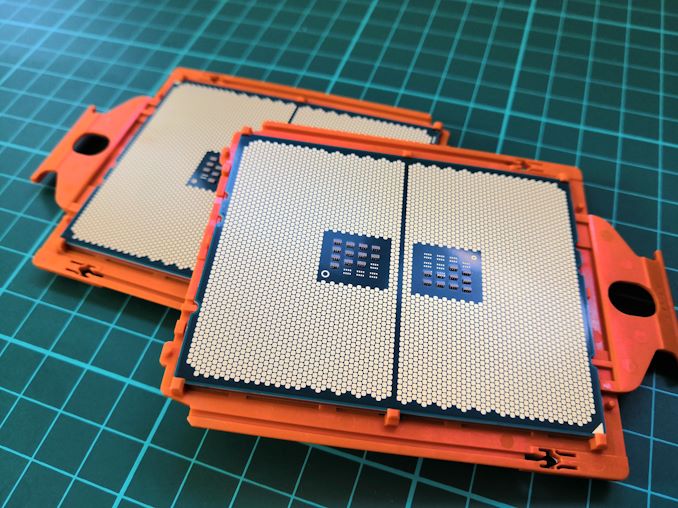
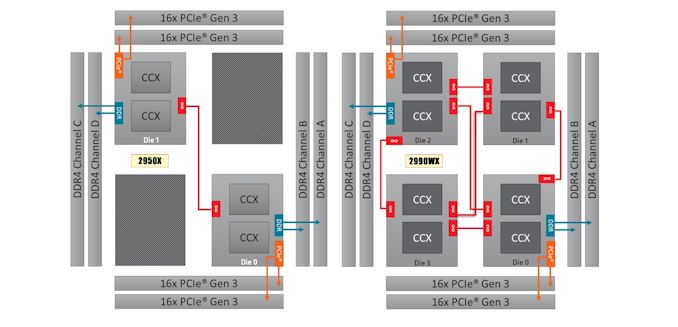
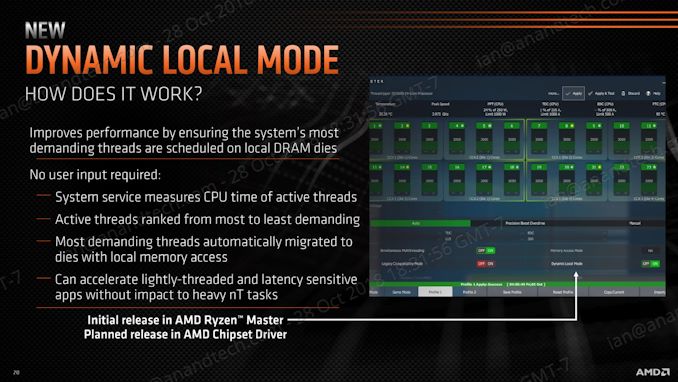
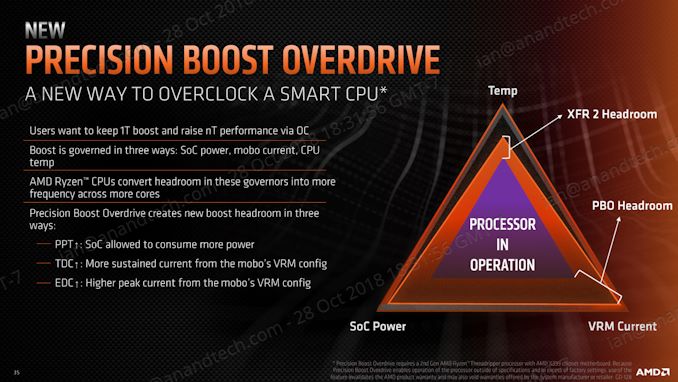
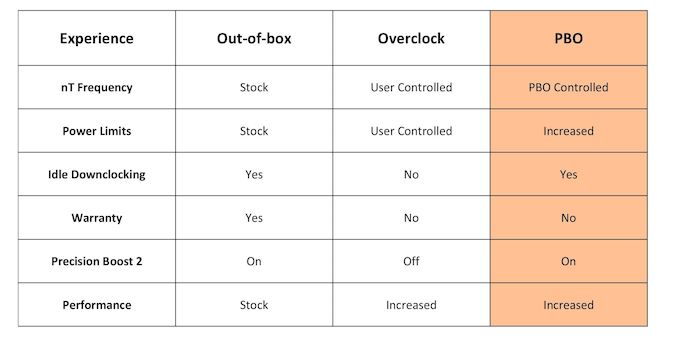
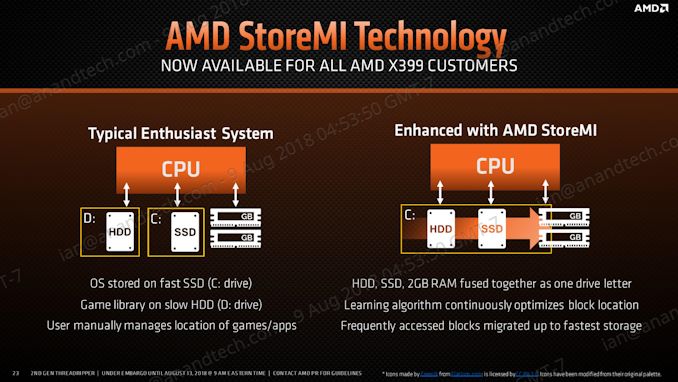








69 Comments
View All Comments
Ian Cutress - Monday, October 29, 2018 - link
EPYC 7601 is 2.2 GHz base, 3.2 GHz Turbo, at 180W, fighting against 4.2+ GHz Turbo parts at 250W. Also the memory we have to use is server ECC memory, which has worse latencies than consumer memory. I've got a few EPYC chips in, and will be testing them in due course.mapesdhs - Monday, October 29, 2018 - link
Does the server memory for EPYC run at lower clocks aswell?GreenReaper - Wednesday, October 31, 2018 - link
ECC RAM typically runs slower, yes. It's correctness that you're looking for first and foremost, and high speeds are harder to guarantee against glitches, particularly if you're trying to calculate or transfer or compare parity at the same time.iwod - Monday, October 29, 2018 - link
Waiting for Zen2Boxie - Monday, October 29, 2018 - link
only Zen2? Psshh - it was announced ages ago... /me is waiting ofr Zen5 :Pwolfemane - Monday, October 29, 2018 - link
*nods in agreement* me to, I hear good things about Zen5. Going to be epyc!5080 - Monday, October 29, 2018 - link
Why are there so many game tests with Threadripper? It should be clear by now that this CPU is not for gamers. I would rather see more tests with other professional software such as Autoform, Catia and other demanding apps.DanNeely - Monday, October 29, 2018 - link
The CPU Suite is a standard set of tests for all chips Ian tests from a lowly atom, all the way up to top end Xeon/Epyc chips; not something bespoke for each article which would limit the ability to compare results from one to the next. The limited number of "pro level" applications tested is addressed in the article at the bottom of page 4."A side note on software packages: we have had requests for tests on software such as ANSYS, or other professional grade software. The downside of testing this software is licensing and scale. Most of these companies do not particularly care about us running tests, and state it’s not part of their goals. Others, like Agisoft, are more than willing to help. If you are involved in these software packages, the best way to see us benchmark them is to reach out. We have special versions of software for some of our tests, and if we can get something that works, and relevant to the audience, then we shouldn’t have too much difficulty adding it to the suite."
TL;DR: The vendors of the software aren't interested in helping people use their stuff for benchmarks.
Ninhalem - Monday, October 29, 2018 - link
ANSYS is terrible from a licensing standpoint even though their software is very nice for FEA. COMSOL could be a much better alternative for high-end computational software. I have found the COMSOL representatives to be much more agreeable to product testing and the support lines are much better, both in responsiveness and content help.mapesdhs - Monday, October 29, 2018 - link
Indeed, ANSYS is expensive, and it's also rather unique in that it cares far more about memory capacity (and hence I expect bandwidth) than cores/frequency. Before x86 found its legs, an SGI/ANSYS user told me his ideal machine would be one good CPU and 1TB RAM, and that was almost 20 years ago.